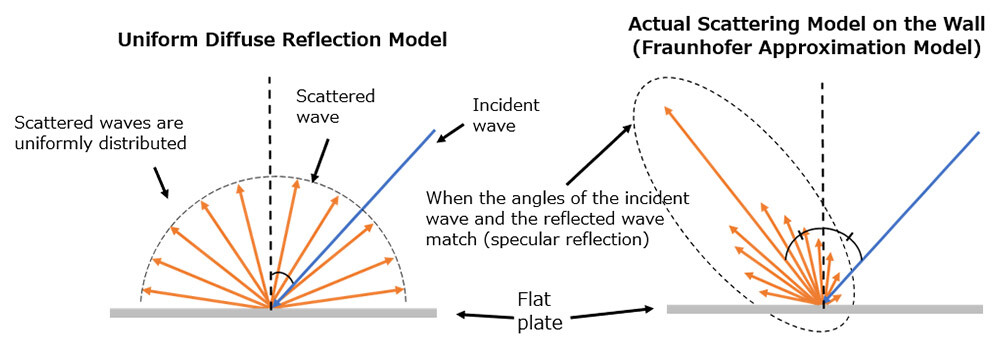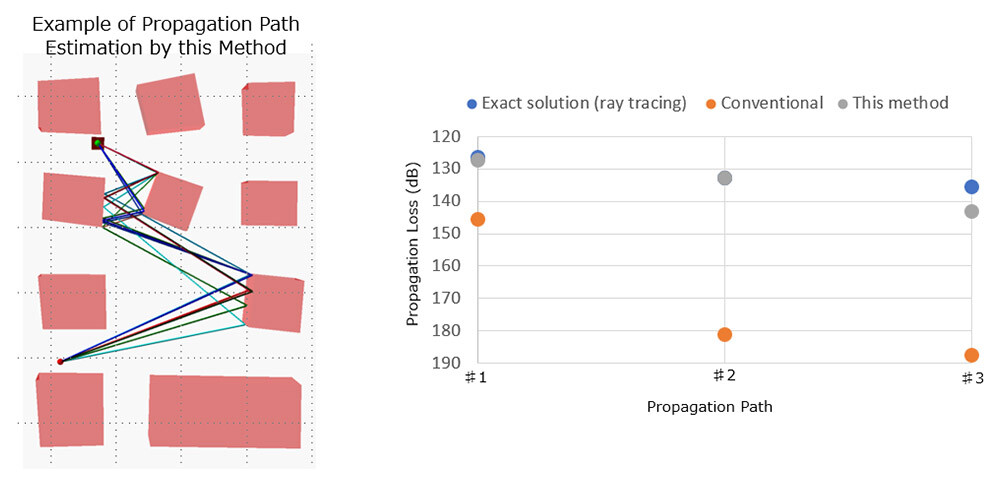Microsoft ends support for Internet Explorer on June 16, 2022.
We recommend using one of the browsers listed below.
- Microsoft Edge(Latest version)
- Mozilla Firefox(Latest version)
- Google Chrome(Latest version)
- Apple Safari(Latest version)
Please contact your browser provider for download and installation instructions.
October 25, 2023
NTT Corporation
Tokyo Denki University
World's first successful development of technology capable of estimating wireless quality with high speed and accuracy using current quantum annealing machines
Realtime optimization of wireless resources for the 6G/IOWN era, including autonomous driving
Tokyo - Oct. 25, 2023 - NTT Corporation (NTT) and Tokyo Denki University (TDU) have developed the world's first algorithm for simulating radio wave propagation that achieves both ultra-high speed and high accuracy, and have demonstrated its effectiveness on an actual quantum annealing machine. This is expected to contribute significantly to the realization of wireless communication services that continue to connect all terminals required in the 6G/IOWN era, including autonomous operation.
Through this technology, wireless communication quality estimation of various wireless communication systems for individual terminals in the cyberspace constructed on the network can be performed in real-time in the order of msec and with high accuracy with errors of several dB. By using this information as control information for wireless communication systems in the physical space, it is possible to provide optimum wireless communication quality in real-time for each user.
The results will be exhibited at the NTT R&D Forum - IOWN ACCELERATION [1], which will be held from November 14th to 17th, 2023.
1. Background
Society5.0 proposes a people-centered society that achieves both economic development and the resolution of social issues through a highly integrated system of cyberspace and physical space [2]. In the next generation of mobile communication systems, the wireless communication quality, which changes in complexity from moment to moment, can be estimated in real-time in cyberspace with high accuracy, and utilized for network control in physical space, thereby realizing the wireless communication services required in the 6G/IOWN era to continue to be connected at high speed, high capacity, and high reliability.
The ray-tracing method, which is a typical simulation method for estimating radio communication quality, requires a large amount of calculation time due to the need to search for the path of radio waves and perform complex calculations on the effects of radio waves such as reflection and diffraction. In December 2022, NTT and TDU devised the world's first propagation QUBO [3] model that operates on an annealing machine [4], and developed a technology [5] that reduces the calculation time by more than one millionth compared to the conventional ray-tracing method that runs on a Neumann computer [6].
The above technology uses a fully diffuse reflection model that uniformly distributes the scattering of radio waves in all directions (Figure 1), which enables us to estimate the wireless communication area with a planar spread in cyberspace where the actual environment is reproduced at a very high speed. However, in order to perform flexible network control to ensure desired quality for individual terminals tailored to the location, time, and person under consideration in next-generation mobile communications (6G), it is necessary to achieve location-specific wireless communication quality estimation with high accuracy while maintaining high speed. For this purpose, it was necessary to incorporate into the propagation QUBO model the relationship between the angle incident on a wall and the angle emitted, as shown in Figure 1, for the scattering of radio waves in an actual environment.
 Figure 1 Wave Scattering Model at the Wall
Figure 1 Wave Scattering Model at the Wall
2. Technology Overview
Wireless communication quality estimation, which is required in a system where cyberspace and physical space are highly integrated, achieves both high speed in the order of msec and high accuracy with errors of several dB. In addition, for practical use, calculations must be able to be performed within the qubit number provided by current annealing machines.
NTT and TDU have been developing a new estimation method that can simulate wireless communication quality at high speed by replacing quality with energy, and now we have devised a new propagation QUBO model that can be implemented on an annealing machine to solve these three problems simultaneously. As a result, we were able to achieve high accuracy in estimating the quality of wireless communications for pinpoint locations while maintaining the real-time performance achieved by conventional technologies. In addition to verifying the operation by pseudo-quantum annealing, we succeeded in actually operating the propagation QUBO model devised by a loosely coupled [7] 5640 qubit quantum annealing machine, and confirmed the effectiveness of the algorithm on a real machine.
The two technical points are as follows.
- High-speed and high-precision technology for estimating radio communication quality
The Fraunhofer approximation, which can simulate the scattering of radio waves on building walls, was successfully introduced into the QUBO model. This greatly improved the accuracy of wireless quality estimation in cyberspace, where the actual environment is reproduced. The calculation model, which corresponds to an area of about 50 m square with a complicated path of radio waves, showed that the error of the conventional technique against the ray trace method, which is an exact solution under the condition of 3 scattering times, was 10dB or more for the top 3 paths with a small loss amount, but the error of 1dB or less was realized for the top 2 paths with this technique (Figure 2). This result is equivalent to satisfying the accuracy required for stable control of communication quality fluctuations due to terminal movement. As with the prior art, this technology reduces the calculation time by more than one millionth compared to the ray-trace calculation on a Neumann-type computer, confirming that the high speed is maintained. Figure 2 Comparison Between an Example of Radio Wave Path Estimation by this Technology and the Estimation Result
Figure 2 Comparison Between an Example of Radio Wave Path Estimation by this Technology and the Estimation Result
- Quantum bit reduction technology required for calculation
Since the number of qubits available in current quantum annealing machines is not large enough for large-scale computation of this technology, it was necessary to establish a technique to reduce qubits to an available level. Therefore, by taking into consideration the nature of radio waves in building structures, we have established a technology to suppress the explosion of the number of combinations of radio wave paths. A large-scale calculation of 7 scattering times using an actual city model (450 planes) reduced the number of qubits required to 1/25, which is within the number of qubits provided by current annealing machines.
3.Values provided by the technology
By enabling wireless communication quality estimation with both real-time performance and high accuracy on current annealing machines, we have paved the way for optimizing wireless resources such as frequency, time, and space for each wireless terminal at the level of providing qubits in real products. In the future, we can expect to create new mobility services such as network support for autonomous driving, which requires thorough safety and security for each vehicle, by flexibly controlling the radio wave environment at the terminal level.
4.Role of each institution
NTT: Concept design and simulation evaluation of wireless communication quality estimation by quantum annealing
TDU: Algorithm design using quantum annealing
5.Outlook
In the future, we will continue to develop technologies to achieve the 99.99999% reliability target of 6G. In addition, the algorithm will be incorporated into a wireless communication network to further demonstrate a wireless system that continues to be connected at high speed, high capacity, and low delay, with the aim of establishing the technology by 2030. We will also contribute to the rapid expansion of use cases that continue to be connected, such as the realization of a society in which applications that enrich people's lives can be used safely and securely.
<Glossary>
[1]"NTT R&D FORUM 2023 - IOWN ACCELERATION" Official Website
https://www.rd.ntt/e/forum/
[2]Society5.0:
A people-centered society that achieves both economic development and the resolution of social issues through a system that highly integrates cyberspace and physical space
[3]QUBO:
A quadratic polynomial problem in which each variable is assigned a binary variable of 0 and 1 so that the value of the quadratic expression is minimized
[4]Annealing Machine:
A type of computer dedicated to finding approximate solutions to optimization problems
[5]Neumann-type Computer:
Computer composed of a system that sequentially calls instructions stored in a CPU and a storage device and executes them one by one
[6]Release " NTT Succeeds in Developing the World's Fastest Wireless Communication Area Estimation Technology ":
https://group.ntt/en/newsrelease/2022/12/05/221205a.html
[7]Loose Coupling:
In the Ising model, which is a component of the annealing machine, spins are connected only to specific spins, and only some spins interact with each other.
About NTT
NTT contributes to a sustainable society through the power of innovation. We are a leading global technology company providing services to consumers and business as a mobile operator, infrastructure, networks, applications, and consulting provider. Our offerings include digital business consulting, managed application services, workplace and cloud solutions, data center and edge computing, all supported by our deep global industry expertise. We are over $95B in revenue and 330,000 employees, with $3.6B in annual R&D investments. Our operations span across 80+ countries and regions, allowing us to serve clients in over 190 of them. We serve over 75% of Fortune Global 100 companies, thousands of other enterprise and government clients and millions of consumers.
Media contacts
NTT
Public Relations, Information Network Laboratory Group
nttrd-pr@ml.ntt.com
Tokyo Denki University
Planning and Public Relations, General Affairs Department
keiei@jim.dendai.ac.jp
Information is current as of the date of issue of the individual press release.
Please be advised that information may be outdated after that point.
NTT STORY
WEB media that thinks about the future with NTT










